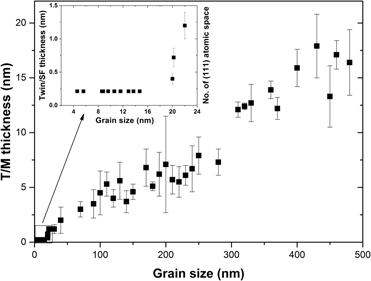Article contents
Grain size effect on deformation twin thickness in a nanocrystalline metal with low stacking-fault energy
Published online by Cambridge University Press: 14 June 2019
Abstract

Grain size effect on twin thickness has been rarely investigated, especially when the grain size is less than 1000 nm. In our previous work (Mater. Sci. Eng.A527, 3942, 2010), different severe plastic deformation techniques were used to achieve a wide range of grain sizes from about 3 μm to 70 nm in a Cu–30% Zn alloy. Transmission electron microscopy (TEM) revealed a gradual decrease in the deformation twin thickness with decreasing grain size. In the present work, high-resolution TEM was used to further identify deformation twins and measure their thickness, especially for grain sizes below 70 nm. The twin thickness was found to gradually reduce with decreasing grain size, until a critical size (20 nm), below which only stacking faults were observed. Interestingly, the relationship between twin thickness and grain size in the ultrafine/nanocrystalline regime is found similar to that in the coarse-grained regime, despite the differences in their twinning mechanisms. This work provides a large set of data for setting up a model to predict the twin thickness in ultrafine-grained and nanocrystalline face-centered cubic materials.
- Type
- Invited Paper
- Information
- Journal of Materials Research , Volume 34 , Issue 13: Focus Issue: Intrinsic and Extrinsic Size Effects in Materials , 15 July 2019 , pp. 2398 - 2405
- Copyright
- Copyright © Materials Research Society 2019
References
- 10
- Cited by




